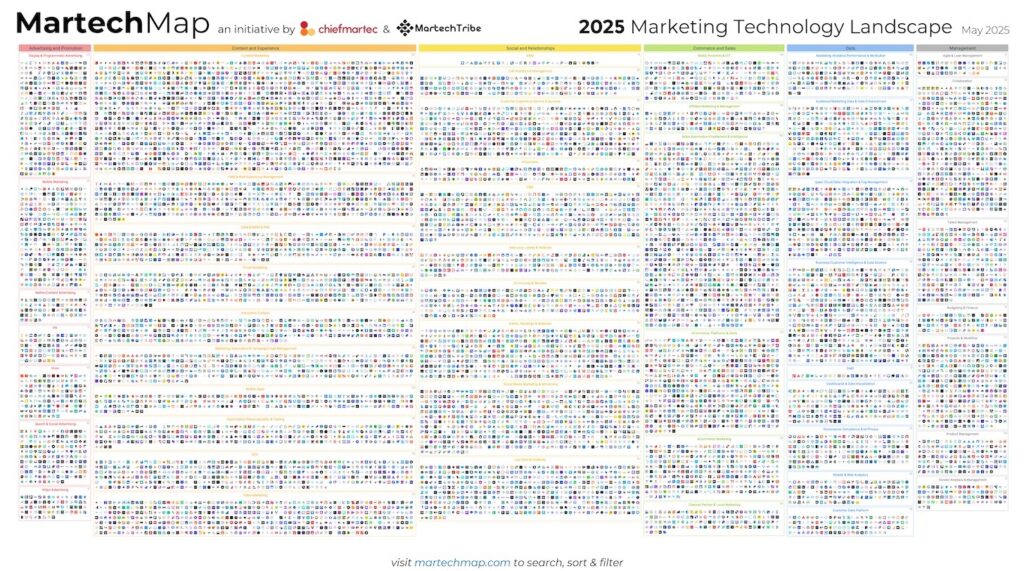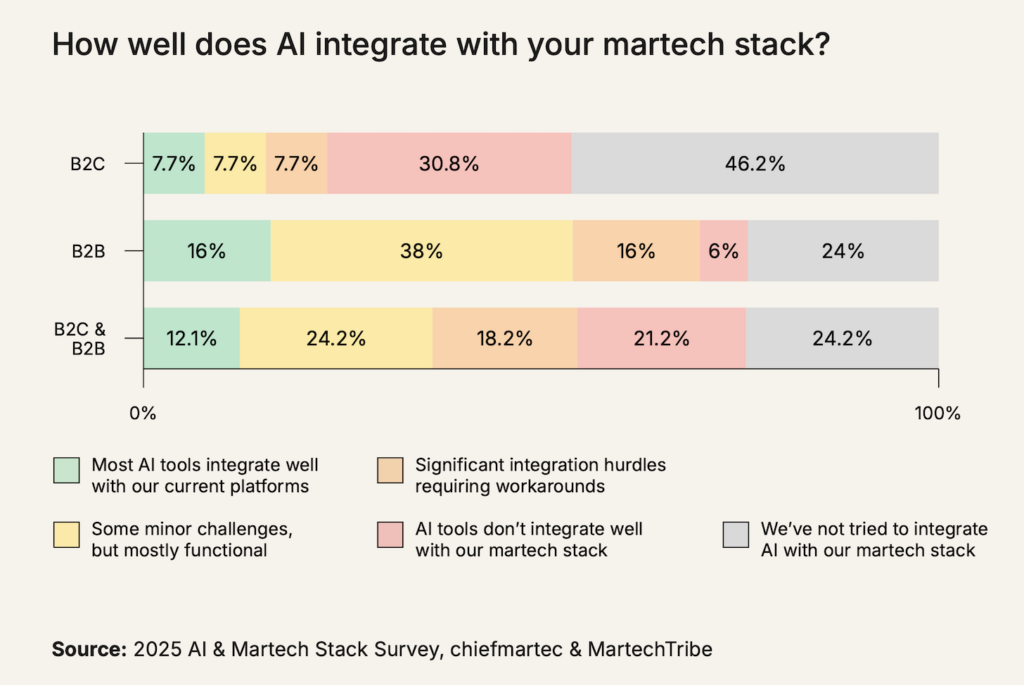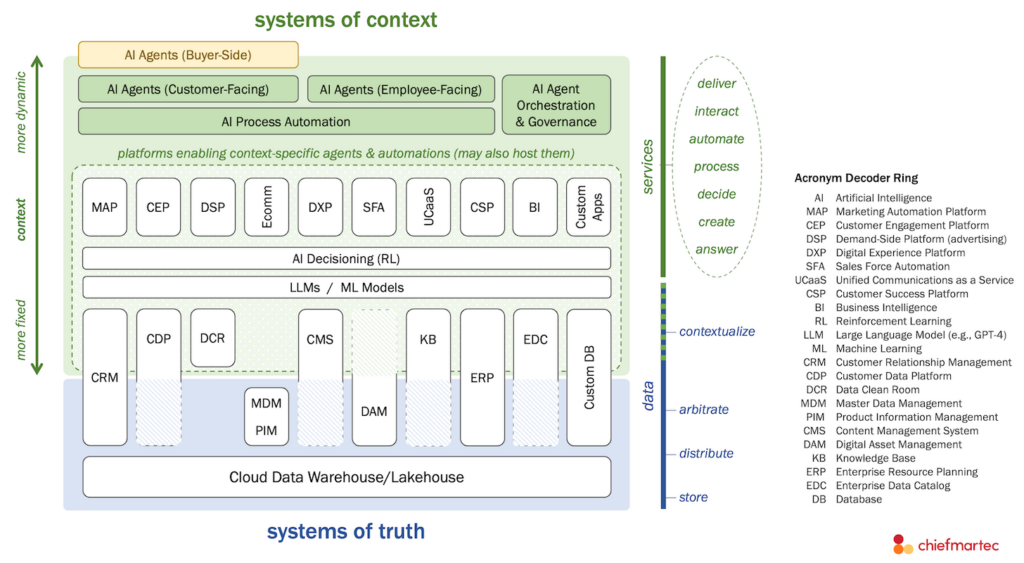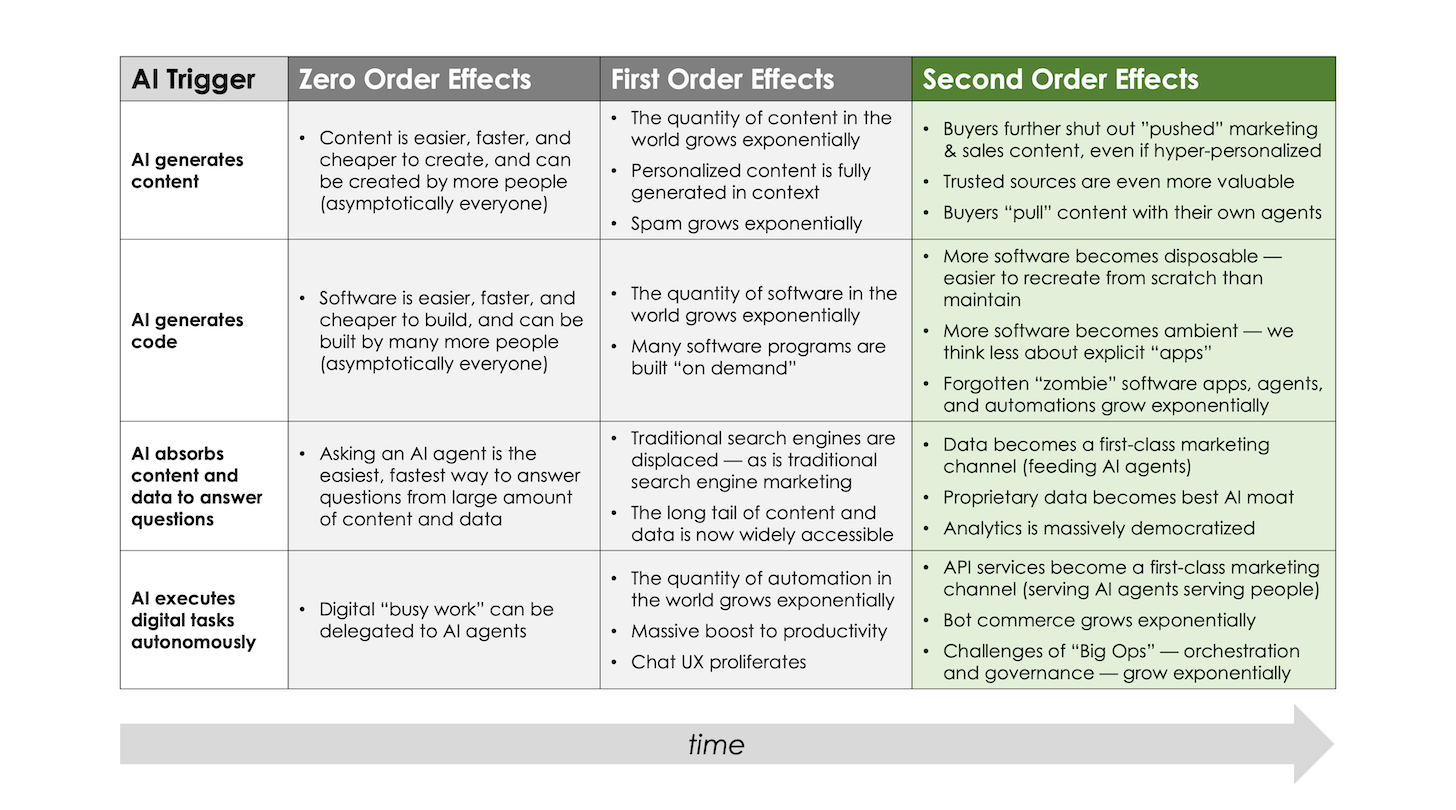
What an amazing time to be working in marketing and martech! Our entire industry is blossoming like the wildflower “super bloom” happening in California this spring, fed by the rain, rivers, and sunshine of generative AI, universal cloud data warehouses, and software composability.
There’s literally gold flowing down from the mountains in California — and figuratively from the rush of AI-powered innovation flooding the Valley.
Before I forget: don’t miss the opportunity to catch 21 free talks from some of the leading experts and practitioners in martech next Tuesday, May 2, #MartechDay. Frans Riemersma and I are hosting the Best of Breed Marketing Summit to release the 2023 marketing technology landscape, celebrate the 2023 Stackie Awards, and dig into the technological and organizational changes happening around us.
Register for free and join us for an hour or the day.

But today, I want to share with you some preliminary thoughts about the second-order effects we may see from the many disruptions born of generative AI.
We’ve all read a lot about the zero-order effects of generative AI. It makes content easier, faster, and cheaper to create. Code easier, faster, and cheaper to build. It answers obscure questions faster than a speeding bullet. Leaps tall piles of structured and unstructured data in a single bound. And with Auto-GPT, AgentGPT, BabyAGI, ChatGPT Plugins, etc., it’s now able to run digital errands for us like an eager Jimmy Olsen on a photo assignment.
(Sorry for a super overextended metaphor.)
There’s also a ton of discussion about the first-order effects that will likely result. There’s going to be a lot more content out there. A lot more code. Disruption to traditional search engines such as Google Classic. And the proliferation to “chat UX” in so many of the software apps we use.
These are fascinating, powerful, disruptive effects. But they’re fairly easy to predict. You can draw a straight line from the trigger (“AI generates content”) to the outcome (“the quantity of content in the world grows exponentially”).
To me, some of the more interesting questions are what the second-order effects will be. What subsequent disruptions will those massive first-order effects trigger for marketing, martech, and digital business?
When AI generates seller content, what do buyers do?

Let’s start with AI generating content. The most obvious first-order effect is that there will be an explosion of content. Remember content shock 10 years ago? That’s going to seem like a ticklish static electric zap from rubbing your winter shoes on the carpet in comparison to grabbing a high-voltage powerline of this new AI-powered content shock.
The coolest first-order effect is that such content will increasingly be generated for individuals, based on everything we can know or infer about them, in the context of the specific moment in which it’s served up. After nearly 30 years of hyperbole about 1:1 personalization, generative AI will finally fulfill that promise.
But there’s a dark side to that. Effortless, instantaneous personalized content is going to also mean effortless, instantaneous spam. Content spam will flood the Internet — including all the junk of deep fakes, misinformation, and general rubbish. (Time to update your iconic Crap presentation, Doug Kessler. We’re talking an Oppenheimer scale explosion of crap now.)
It’s also going to result in an order of magnitude increase in the number of automated comms pushed to people on every conceivable channel — email, phone, SMS, ads, social media, WhatsApp, etc. Generative AI will spawn an infinite army of automated BDRs and SDRs. Many of which will actually be quite good, delivering hyper-personalized messages.
But it will be too much, from too many. Too fast, too furious.
These first-order effects will trigger second-order effects that will fundamentally change marketing and sales. Here’s what I expect:
Buyers will further tune out “pushed” marketing and sales content, even though it’s hyper-personalized. Spam filters will get a lot better at stemming the incoming tide and only notify the recipient of a brief summary of things that they might be interested in. Ironically, as a result, all these über-personalized messages won’t signifcantly improve sales prospecting efficacy. They’ll likely reduce it.
Trusted sources will become even more valuable. Communities with verified members will be golden. Influencers who have built their own audiences and aren’t overly dependent on external algorithms for discovery and delivery will carry significant weight. We will crave real human perspective.
As we already see today with ChatGPT, buyers will increasingly adopt an AI-mediated “pull” approach to discovering and evaluating products and services. Generative AI is much better suited to plow through the mountain of content and offerings out there to summarize recommendations. These buyer-centric AI agents will wield enormous power. As we’ll discuss further, the goal of marketing will be to serve these intermediary agents well.
AI generates code, software multiplies, apps evolve

Creating software was already well on its way to being democratized by low-code/no-code products and interfaces. And by “software,” I really mean any digital program or interactive asset: apps, automations, websites, workflows, etc. Today, millions of non-developers use tools such as Airtable, Webflow, and Zapier to build their own tailored experiences and operations.
But mostly power users.
Generative AI has now pushed us further down the curve of technology democratization by making it possible for any ordinary person to create a “software program” by making a series of natural language requests to an AI agent. In fact, it’s clear that more and more of these programs will be created ambiently/automatically in the background without a user even explicitly recognizing that an act of creation took place on their behalf.
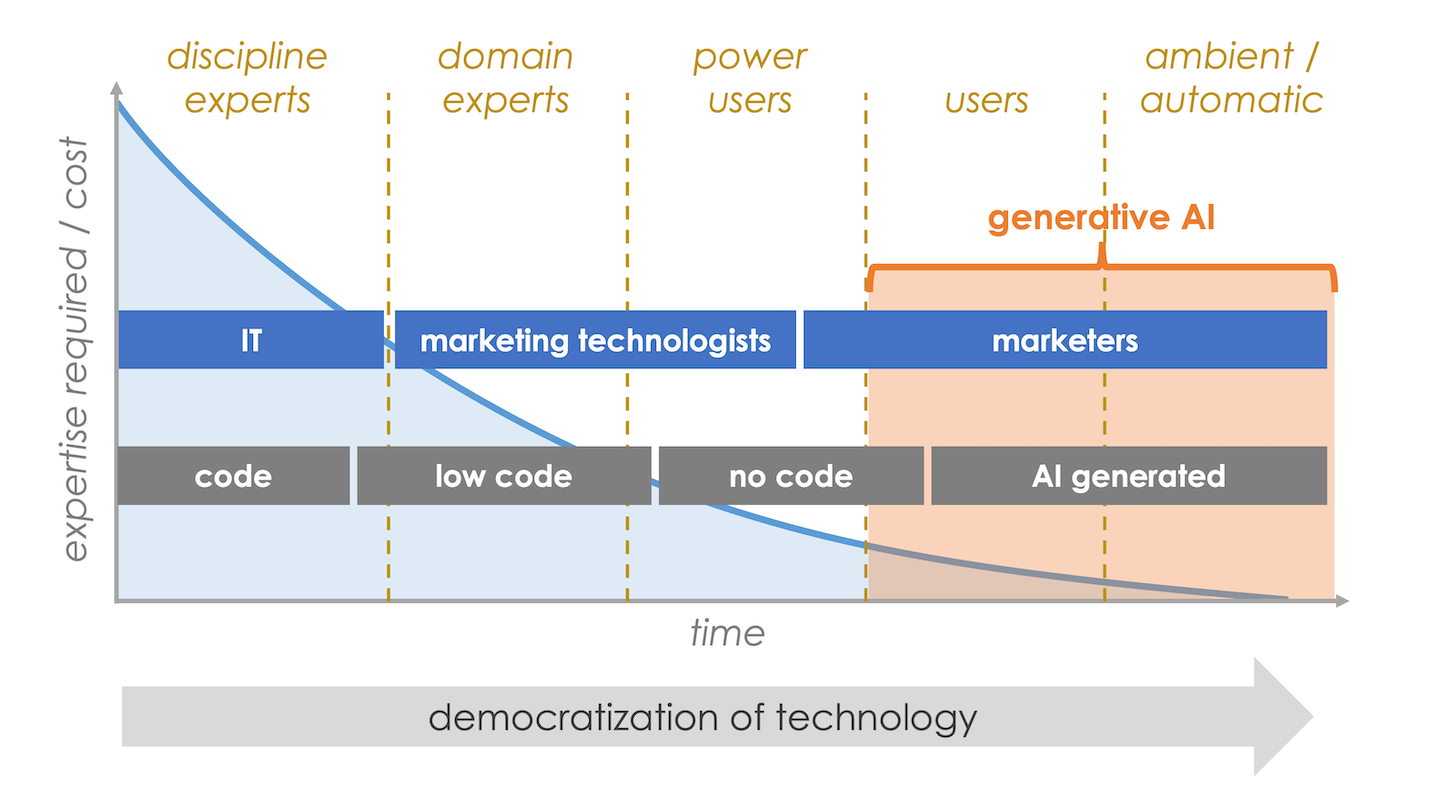
The obvious first-order effect here is that the total quantity of software in the world is going to grow exponentially. And that many of these software programs will be built on-demand by users, rather than designed by professional software engineers.
That’s not to say there won’t still be professionally developed software apps and platforms. There most certainly will be, especially for larger and more complex products. (Although that development process will also be greatly augmented and accelerated by AI coding copilots.) But by sheer volume, AI-generated programs will soon dwarf human-built ones.
As it is with content, so shall it be with code.
This first-order “app shock” explosion will trigger second-order effects that will change the way we think about software and the economics around it:
Because so many software programs will be so easy to create on-demand, software will become more disposable. Instead of the painful slog of maintaining old custom apps and automations — the “tech debt” problem that has plauged companies for decades — it will often be easier to recreate programs from scratch. Composable architectures and a universal data layer will play a big role in making this feasible.
The Great App Explosion will accelerate. But with more AI agents operating across apps and interfacing with us through natural language and ambient interfaces, we’ll think less explicitly about apps as discrete things. Just as we’ve been using Google Search — well, Google Classic, that is — one of the world’s most advanced software programs without really thinking about it as an “app” at all, we’ll have dozens or hundreds of such AI-created and AI-powered programs we take for granted throughout our day.
A negative second-order effect will be a whole lot more “zombie” apps and automations floating around. Software programs that get created and then forgotten, shambling around in the shadows, eating resources and haunting organizations with mysterious effects from time to time. There will be a big market for solutions to this growing Big Ops “visibility gap.”
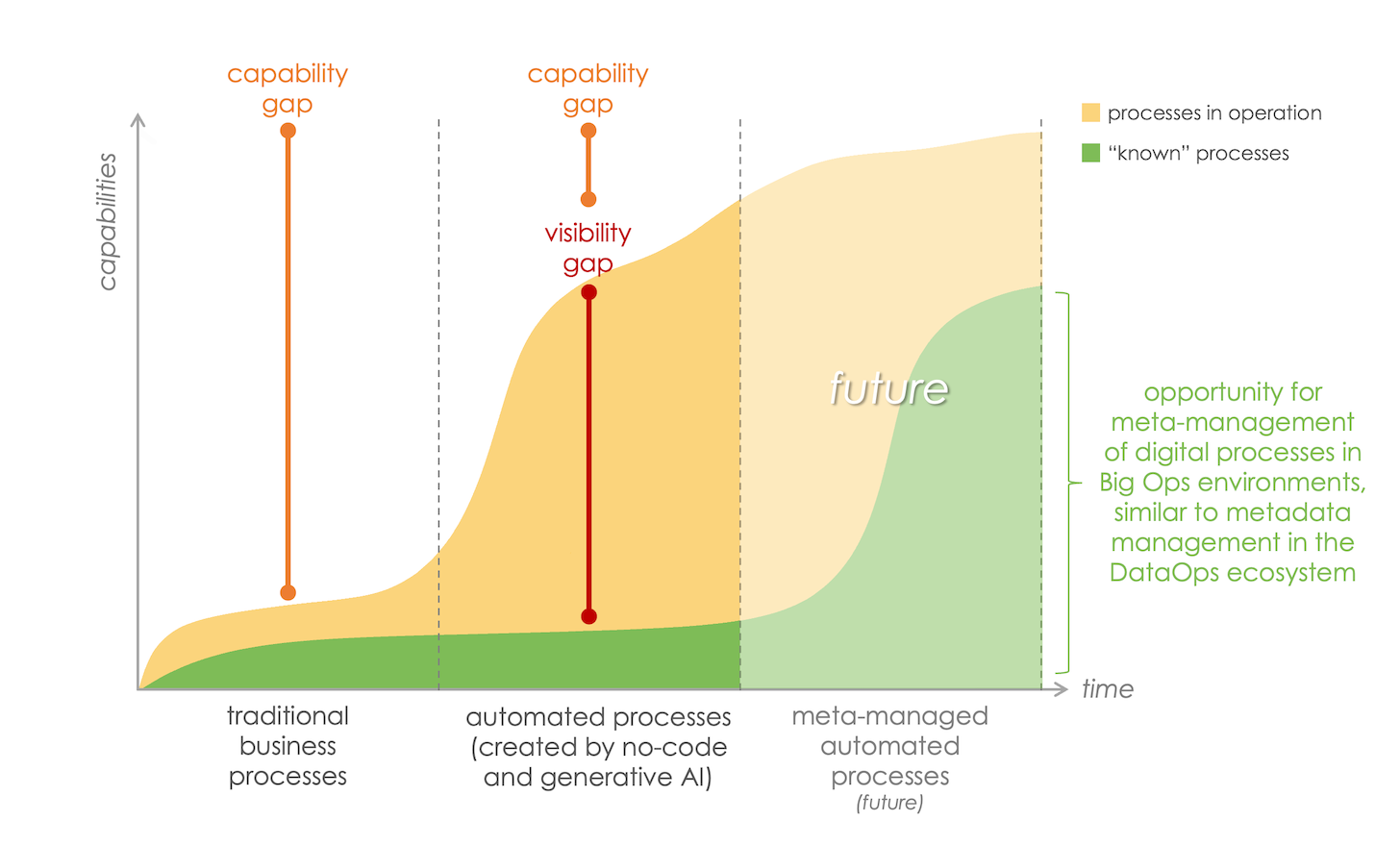
AI unlocks the long, long, long tail of content and data

The irony of the massive amount of content and data that has been created and collected over the past two decades is that the vast majority of it is inaccessible. I don’t mean it’s inaccessible from a permissions perspective (although hopefully that’s a factor where it should be!). I mean that you simply can’t find it, consume it, or understand it because there’s just too damn much of it.
In theory, if it’s on the web, it was accessible via Google Search — Google Classic, I’ll disclaim again. But in truth, no one would ever get past the first page or two of search results. And even that left you as a human to parse the websites on the other side of those blue links, sorting through godawful user experiences with a ton of expired, irrelevant, or just plain bad content.
The same goes for the vast majority of data in company data warehouses. They’re like that gargantuan warehouse in the final scene of Raiders of the Lost Ark. The effort required by a mere mortal to find something in that abyss would frighten even Kafka.

But now LLM-powered AI such as GPT-4 can easily consume all of that content and data, and then — in a fraction of a minute — answer almost any question you ask. It’s absorbed all of the long, long tail of content on the Internet. And in privately-tuned versions indexed the depths of your own data warehouse.
This is why an obvious first-order effect is that traditional search engines (Google Classic) will be displaced. These new AI agents serve the job-to-be-done — quickly find something from the tomes of human knowledge — much, much better. Classic business intelligence software will be similarly transformed.
As a second-order effect, analytics will be massively democratized. The range of questions anyone in a business will be immediately able to self-service an answer to will be stunning.
Because access to all the content on the open web will be commoditized by foundational models such as GPT-4, competitive advantage will go to those with unique and proprietary data. Everybody will have the same AI engines. Not everybody will have the same data to feed them. Their growth will be way more nurture than nature.
A second-order effect of this hunger for proprietary data will be opportunities for marketers to market by feeding datasets across their go-to-market ecosystems. Data will become a first-class marketing channel.
As AI runs our digital errands, digital services thrive

As I write this very sentence, developers around the world are madly launching new AI agents that marry ChatGPT with the ability to execute tasks. I mentioned a few earlier. JARVIS is another one worth looking at. It takes a request from a user, breaks it down into discrete tasks, looks up different machine learning models on the AI open source community HuggingFace, picks the best one for each task, runs them in sequence, and then stitches everything together into the result.
If you aren’t impressed — jaw-dropped-open impressed — you aren’t paying attention.
All of these are science-fair projects at the moment, not ready for mainstream adoption. But given the pace at which they’re advancing, there will be a wave of consumer quality agents in service before this year is out.
The first-order effects are parallel to the other triggers we’ve discussed: the quantity of automations and automated task executions in the world are going to grow expondentially. This will deliver a massive boost to productivity. “Chat UX” interfaces will be everywhere, prompting us for anything we want done.
The biggest second-order effects of this for marketers will be that serving these agents becomes a major part of their job. Helping AI help buyers will be the best way for sellers to help themselves. Just as we used to optimize content for search engines (SEO) in order to be found by buyers, we’ll optimize data and services for consumption by these AI agents acting on a buyer’s behalf.
Just as data will become a first-class marketing channel, API services will become a first-class marketing channel too. This is how we’ll serve the right data to AI agents at the right time. It’s also how we’ll give them easy ways to take actions with us.
The most obvious and exciting action? Making a purchase.
Bot-to-bot commerce — the new B2B? — will become a huge portion of ecommerce.
Two decades ago, the inbound marketing revolution was launched. Helping people answer questions to win new business. We’re now on the verge of what we could call a generative inbound marketing revolution — fielding inbound requests from AI agents to help them accomplish the goals they’ve been assigned by their human controllers.
For both buyers and sellers this is going to raise the stakes and the complexity of Big Ops. Orchestrating and governing all of the automations and autonomous agents inside your organization, as well as managing all of the AI agents engaging with you from prospects, customers, and partners, is going to be an epic responsibility.
The opportunity for innovation with these second-order effects is colossal.
